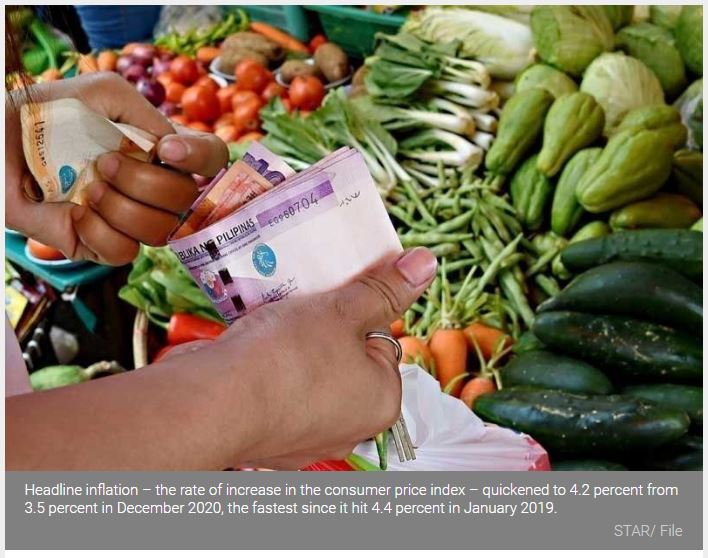Philippines: Stagflation unlikely despite current price surge — Moody’s unit
MANILA, Philippines — The Philippines is not suffering from stagflation and the risks of doing so in the future is nil as the economy is still expected to rebound despite what government said was a slow start this year.
“There is no reason to worry about stagflation. At least not yet,” Steven Cochrane, chief Asia Pacific economist at Moody’s Analytics, said in a research note on Tuesday.
When reached out for further comment, Cochrane added the risks of the Philippines falling to the unwarranted combo of recession and spiking prices is “small.” “Consumer spending and investment will likely accelerate economic growth through the rest of this year,” he said in an email.
Fears of the economy falling into stagflation were fanned last week by a government report that showed inflation soared to 4.2% year-on-year in January, which was not only a 2-year high but also breached the central bank’s annual 2-4% target for the year. This happened despite gross domestic product shrank a record 9.5% for all of 2020.
Stagflation happens when economic stagnation is compounded by expensive prices of basic goods and services, a double-whammy that presents a dilemma to policymakers trying to resolve both things that theoretically require different economic manuevers.
Economic officials led by central bank Governor Benjamin Diokno already downplayed the likelihood of stagflation, saying spurts of monthly inflation should decelerate soon. Acting Socioeconomic Planning Secretary Karl Kendrick Chua also pointed out over the weekend that the inflation target “is for the full year, not for the month.”
Cochrane, in his assessment, appeared to agree with the government’s observations. Indeed, one single inflation print hardly represents a trend, and for stagflation to be confirmed, he said a “persistent period” of high inflation, slow growth and massive unemployment should materialize.
“The Philippines economy right now is quite dynamic and does not fit these criteria,” he explained.
In addition, price upticks also appeared to be limited to the heavily weighted food products due to tight supplies of pork and vegetables, and do not necessarily spread to other commodities like education. Justifying this assessment, Cochrane cited the stable core inflation, which strips out volatile food and energy prices, that largely remained steady at 3.3% last month.
For now, as lockdowns get eased and manufacturers begin to pick up some slack, supply shortages meeting “pent-up demand” that trigger inflation is only expected, but should taper down sooner rather than later. The jobless rate, which rose to 17.6% in April before going down to 8.7% in October, should go back to pre-pandemic levels of “about 5%.”
At the same time however, Moody’s Analytics said inflation would likely continue to accelerate, although this will be driven by economic recovery and therefore does not meet the criteria for stagflation. Moody’s Analytics, a unit of Moody’s, itself projects gross domestic product to grow 6.8% year-on-year in 2021.
“There is no guarantee that inflation will not accelerate as the economy recovers,” he said.
“Indeed, monthly inflation may be volatile as demand improves in the coming year. But domestic production will also increase and should eventually catch up with improving demand,” Cochrane said.
Source: https://www.philstar.com/business/2021/02/09/2076478/stagflation-unlikely-despite-current-price-surge-moodys-unit


 Thailand
Thailand




